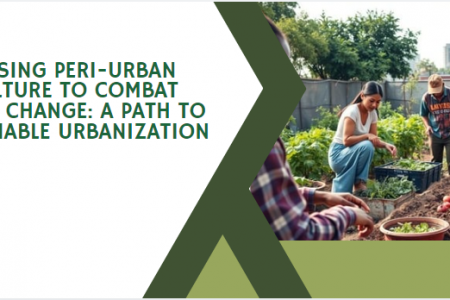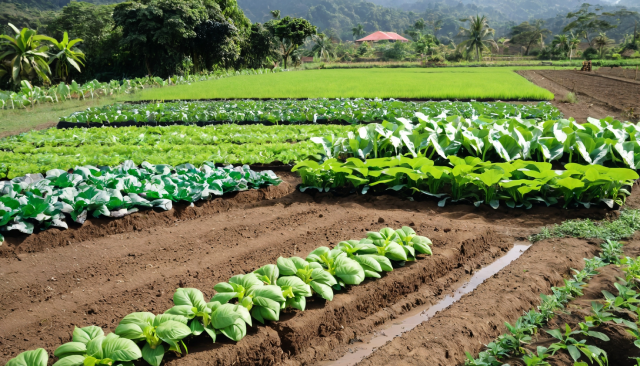As urban centers continue to expand, peri-urban agriculture has emerged as a practical response to both food insecurity and climate change. Positioned on the edges of cities, peri-urban farms offer environmental, economic, and social benefits. This practice is gaining recognition as a key strategy for sustainable urban growth. In Delly Brahim, a town near Algiers, peri-urban agriculture is proving its potential to address these challenges, as detailed in the study “Promoting Peri-Urban Agriculture: A Remedy for Climate Change. Case of the Town of Delly Brahim in Algiers“, published in the Environmental Science & Sustainable Development journal.
Defining Peri-Urban Agriculture
Peri-urban agriculture refers to farming on the periphery of cities, offering an accessible, local food source to urban populations. Unlike traditional, rural farms, peri-urban farms minimize the distance food must travel to urban markets, reducing the carbon footprint of food production. This agricultural practice ranges from small community gardens to more industrial-scale operations, all designed to meet the needs of urban dwellers while promoting sustainability.
Climate Benefits of Peri-Urban Agriculture
1. Reducing Carbon Emissions
Food transportation accounts for a significant portion of greenhouse gas emissions. By localizing food production, peri-urban farms significantly cut down on the emissions associated with long-distance food transport. Many also use organic farming methods, which eliminate the need for synthetic fertilizers and pesticides, further reducing their environmental impact.
In Delly Brahim, locally produced food has reduced the town’s reliance on imports, cutting down on emissions while boosting food sovereignty.
2. Building Urban Resilience
Peri-urban agriculture enhances the resilience of urban systems by creating green spaces that help cities adapt to climate-related stress. These farms can reduce the urban heat island effect and improve water retention, helping mitigate the impact of floods and heatwaves.
In Delly Brahim, peri-urban farms have become essential to reducing the temperature and improving air quality in surrounding urban areas, providing a natural buffer against extreme weather conditions.
3. Promoting Biodiversity and Soil Health
Peri-urban agriculture emphasizes ecological farming techniques, which enhance biodiversity and improve soil fertility These practices reduce the need for harmful chemicals and create more resilient ecosystems. In Delly Brahim, crop diversity and the use of natural compost have helped increase soil health and crop yields, making the area’s agriculture more resistant to climate fluctuations.
Challenges and Policy Implications
Despite its advantages, peri-urban agriculture faces challenges, particularly regarding land availability and resource access. Urban sprawl puts pressure on land, making it critical for governments to protect peri-urban farms from being overrun by real estate developments. Effective urban planning is needed to ensure these farms thrive, with investments in irrigation, infrastructure, and market access for farmers.
At Delly Brahim, supportive policies are key to overcoming these challenges. The government’s involvement has helped preserve agricultural land and ensure the success of local farmers, demonstrating how policy frameworks can integrate agriculture into urban planning.
Looking Ahead: The Need for Research and Collaboration
Peri-urban agriculture has shown promise, but more research and collaboration are essential to fully unlock its potential. By examining best practices from diverse regions and sharing insights, cities can scale up these agricultural models, adapting them to different environmental and social contexts. The case of Delly Brahim serves as a successful example, but continued study is required to advance these efforts on a larger scale.
Conclusion
Peri-urban agriculture offers cities an effective way to address climate change, enhance food security, and build resilient urban systems. In Delly Brahim, this practice has reduced carbon emissions, improved food sovereignty, and strengthened the local community. As cities worldwide grapple with the dual challenges of urbanization and climate instability, peri-urban agriculture provides a scalable, sustainable solution. By supporting this agricultural model through research, policy, and community efforts, cities can cultivate a more resilient future.
Visit IEREK Press Journals to explore numerous published articles on these significant topics.
You can read more on these subjects in the following papers in Environmental Science and Sustainable Development journal (ESSD):
– and ’s research paper titled “ Promoting Peri-urban Agriculture: A Remedy for Climate Change. Case of the Town of Delly Brahim in Algiers ”
– ’s research paper titled: “Impacts of Land-Use Transformation on Agriculture Land in Afghanistan, Kabul City as Case Study”
– ’s research paper titled: “Urban Agriculture: A Regenerative Urban Development Practice to Decrease the Ecological Footprints of Cities”

